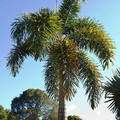It is very important that you familiarise yourself with the most commonly used terms for growing palms. Otherwise you will have a hard time articulating what you want to buy for your palms and how to maintain their health.
Here is a list of the most commonly used terms when growing and caring for palms.
| Acid Soil | This refers to any soil with pH balances below 7.0. While alkaline soil is above 7.0 |
| Bare rooted | You will normally hear this being used by gardeners who are selling plants that have all the soil removed from their roots. |
| Cold Tolerance | This indicates the range of temperature that a particular type of palm is able to grow in i.e. can it withstand frost. |
| Compost | This is a type of organic fertiliser (DIY kind, mostly) that makes use of decomposed matter for fertilising. An example of this would be manure. |
| Crownshaft | The top part of the trunk that holds all the fronds |
| Cultivate | Preparing the soil for growing plants. Removing weeds, softening the soil and perhaps fertilising |
| Dioecious | One plant has female flowers and another plant has male flowers .i.e. two plants are needed for reproduction. |
| Germinate | This is the process where the seed sprouts. |
| Genus | Family of plants, i.e., Wine palm |
| Monocot | Palms are monocots, having one cotyledon (seed-leaf) as opposed to dicots with two. |
| Monecious | Both male and female flowers are on the same plant and therefore only one plant is needed for reproduction |
| Monotypic | Only one genus, i.e. Coconut palm |
| Moisture or Humidity Level | This refers to the plant’s ability to grow in spite of humid conditions. Again, tolerance level is categorized in three types: low, moderate, and high with maximum humidity percentages of 50%, 74%, and more than 75% respectively. |
| Mulch | This refers to any type of loose material that can be placed on top of the soil for conserving its moisture level as well as regulating weed growth. |
| Nutrients | These are the types of nutrients or minerals that a plant needs. |
| N P K | These letters are used to analyse the chemical breakup of commercial chemical fertilizers. N is for Nitrogen, P is for Phosphorus. K is for Potassium. |
| Palmate Palms | Palms that have fan shaped fronds. |
| Pinnate Palms | Palms that have feather shaped leaves. |
| Pest | This term refers to insects, small animals, birds and anything that is a potential carrier of disease and destruction. |
| Spear | This is the new leaf (unformed) coming out of the top of the palm |
| Species | Different types of plants in the same genus, i.e. Butia capitata (species) in the Wine Palm family (genus). |
| Sun Hardened | Has the palm been acclimatised to living in full sun. |
| Salt Tolerance | This refers to the palms ability to tolerate and grow when it is exposed to saltwater or salt air, i.e. low, medium and high. |
| Trunk | This is the main part of the palm from the root ball under the ground to the crownshaft above. |
| Wind Tolerance | This is the palms ability to withstand wind pressure before suffering damage. |
<< Previous Some of the Common Naturally Occurring Australian Palm Trees | Back to Mullumbimby Palm Blog | Next >> The Do's and Don'ts of Palm Pruning



